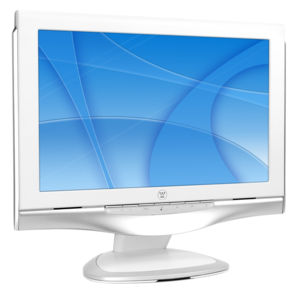 |
|
More Related Stories |
| Page (1) of 1 - 11/09/05 |
|
 |
| The Westinghouse 17" LCM-17w7 LCD monitor |
On the front panel are seven buttons for adjusting volume, backlight brightness, switching between analog and digital inputs, power, and navigating the on-screen display (OSD) menus. The OSD functions are all straightforward and include options to adjust brightness, contrast, black level, color temperature, horizontal and vertical positioning (analog input only), clock, phase, and sharpness (analog input only), as well as adjustments for volume, balance, bass, treble, and muting the sound. The OSD can be displayed in Chinese, Japanese, or English and may be positioned anywhere on the screen. You can also reset everything to the original factory settings. Lastly there is a simple one-click auto adjust feature that automatically fine-tunes the display.
Out of the box the LCM-17w7 includes a VGA cable, power cable, 16-page user manual, and one-year parts and labor warranty card. Setting up the monitor is about as simple as it gets – connect the video cable, a 3.5mm male to male stereo audio cable, the power cable and turn it on. Since the monitor is VESA Plug & Play the computer should recognize it and adjust the signal accordingly but the manual suggests that you should activate the auto adjust feature the first time you use it. I didn’t notice any discernable picture improvement after activating the auto adjust but it didn’t make the picture any worse either. I did find that the factory default brightness settings were a bit ‘hot’ so you might want to adjust things a bit. I use a monitor calibration program called DisplayMate from DisplayMate Technologies (www.displaymate.com) for both routine monitor calibration tasks as well as for benchmarking displays of all types.
I ran the DisplayMate battery of tests and was pleasantly surprised at how well the LCM-17w7 performed on nearly every count. In fact I only found one subtle flaw – a very slight brightness variation along the top inch of the screen. This variation was so slight that it only appeared on one test screen and without the DisplayMate program I never would have noticed. The monitor was perfect on just about every other test and even performed well on the most extreme tests. Resolution, color, sharpness were all spot on. Apart from the one brightness variation the only tests that the monitor couldn’t handle were for geometric distortion and this brings up an interesting point.
Because the LCM-17w7 is a widescreen display it has to convert all 4:3 source images to a 16:9 aspect ratio and that means stretching everything horizontally. Squares become rectangles and circles become ovals. This makes it difficult to test for geometric distortions since the monitor is intentionally distorting the image to fill the screen. This doesn’t mean the monitor is faulty – in fact since it is an LCD screen in the first place it couldn’t have geometric distortions like a CRT display.
When I first fired up the LCM-17w7 I noticed the horizontal stretching right away but after a few days it became less and less noticeable. For most applications the stretching shouldn’t be a problem but for some things like CAD or creating precise graphics for printing the stretched images could be misleading since what you see on the screen is not exactly what you’ll get on paper or on a 4:3 monitor. I only wish there was a way to ‘letterbox’ the image by putting black bars on the sides of the screen for situations when you want a 4:3 image.
In the Westinghouse brochures they tout the LCM-17w7 as ‘HD-Grade’ (a Westinghouse trademarked term) and indicate that this is the perfect back-to-school monitor “that enable students to watch DVD movies or TV, play video games or surf the Internet, as well as work on school papers, projects and spreadsheets.” I would have to agree with them (although you’ll have to have a multimedia PC with DVD drive and TV tuner if you want to watch DVDs or TV). Watching DVDs on the LCM-17w7 is a real treat. The images are pristine, there is no smearing even on fast motion scenes, and while DVDs aren’t really HD you will still get the benefit of the monitor’s high resolution and non-interlaced, progressive-scan display.
 All things considered I would have to rate the Westinghouse LCM-17w7 as a 4.5 out of 5. The very slight brightness variation is virtually unnoticeable in most situations but the horizontal stretching keeps it from attaining a perfect score. If you don’t mind the stretching then the LCM-17w7 is a great monitor for school, home, or office. It delivers a remarkably crisp, bright image, great color, and stylish design all at a very, very nice price.
All things considered I would have to rate the Westinghouse LCM-17w7 as a 4.5 out of 5. The very slight brightness variation is virtually unnoticeable in most situations but the horizontal stretching keeps it from attaining a perfect score. If you don’t mind the stretching then the LCM-17w7 is a great monitor for school, home, or office. It delivers a remarkably crisp, bright image, great color, and stylish design all at a very, very nice price.
For more information visit www.westinghousedigital.com.
 If you liked this article
click here to recommend it.
If you liked this article
click here to recommend it. Page: 1
Page: 1
 Guy Wright
has been kicking around computers and video for more years than he
cares to admit and written too many articles to count. He has been a
director, editor, producer, video operator, and announcer for a score
of radio and TV stations. His credits include hundreds of insipid
local-origination programs and commercials, dozens of cheesy radio
spots, and even a book or two. Mainly he writes and edits articles for
Digital Media Online.
Guy Wright
has been kicking around computers and video for more years than he
cares to admit and written too many articles to count. He has been a
director, editor, producer, video operator, and announcer for a score
of radio and TV stations. His credits include hundreds of insipid
local-origination programs and commercials, dozens of cheesy radio
spots, and even a book or two. Mainly he writes and edits articles for
Digital Media Online.Related Sites: Media Workstation , Corporate Media News , Digital Media Designer , HD Issues , Oceania , Consumer Electronics Net , HomeOffice (CE) , HomeTheater (CE) , Peripherals (CE) , TVs (CE)
Related Newsletter: DMN Newsletter , CMN Newsletter , Pixels Newsletter , HD Weekly , Gadgets Newsletter , Review Seeker
To Comment on This Article, Click HERE
Most Recent Reader Comments:
Click Here To Read All Posts
Must be Registered to Respond (Free Registration!!!, CLICK HERE)


 (Rated by 7 users)
(Rated by 7 users)






